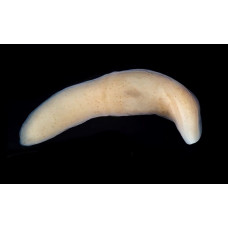The name of the class, Tgematoda, is borrowed from Greek. It means "having suckers".
Trematoda is a class of parasitic flatworms (Platyhelminthes). The body is usually leaf-shaped, less often elongated, length from a few millimeters to 1.5 m (more often up to 5 cm). Have two suction cups - mouth and abdominal. Most are hermaphrodites, some are separate-sexed. Development with a change of hosts and with alternation of generations. In the water from fertilized eggs emerge from the ciliated larvae miracidia, which penetrate into the first intermediate host - pondweed, where they turn into sporocysts. The latter, reproducing parthenogenetically, give a generation of larvae - redia, inside which develop cercarnia. Upon emergence from the radia, cercariae penetrate the body of the second intermediate host - mollusk, fish, amphibians, where they are incysted, turning into metacercariae. Further development occurs in the intestine of the final host after swallowing the second intermediate host. Over 5000 species.
The body shape is often leaf-shaped, sometimes almost round or elongated. The elongated body is usually characteristic of those species that localize in narrow ducts, such as in the bile ducts of the liver, or parasites of the circulatory system. Tissue parasites, often living in special capsules, acquire an almost spherical shape. The presence of a very long (up to 1 m with a width of 1-2 mm) coiled in a ball of filamentous body is characteristic of the family Didymozoidae.
It is characterized by the presence of suction cups - saucer-shaped fossae surrounded by a muscular roll, which contains annular and radial muscle fibers.
Suction cups are pneumatic attachment organs that work effectively in fixation to the soft, delicate tissues of internal organs.
Contraction of the musculature creates a low pressure that suctions the parasite to the host organ walls. There are usually oral and abdominal suction cups. Deep within the oral suction cup is placed the mouth.
The abdominal one serves only as an organ of attachment. Depending on the peculiarities of localization of the parasite, the size, location of the abdominal suction cup on the body of Trematoda can vary greatly. The greatest development of the suction cup reaches those species that live in the intestine of the host, especially in its posterior part.
Trematoda parasitizing in the rectum or cloaca of birds are in the greatest danger of being thrown outward with fecal matter, and therefore the presence of strong attachment organs is especially necessary. The transition of trematodes to parasitization in parts of the digestive tract where peristalsis is not as strong as in other organs of the host results in partial or complete reduction of attachment organs.
Life cycle of heterogony type with alternation of sexual and parthenogenetic reproduction, with change of generations and hosts. The animal in which the hermaphroditic generation of the hermaphroditic salps parasitizes and reproduces sexually is called the definitive (main) host. Animals in which other generations and developmental stages are parasitized are called intermediate hosts. Intermediate hosts in the development of trematodes one or two, the first is always a species of mollusk. The role of the second intermediate host is played by different animals, but always by animals that the main host feeds on. The life cycle of trematodes includes the following stages:
Marita is an adult animal that reproduces sexually and produces eggs.
A miracidium is a larva that emerges from an egg. A miracidium emerges from eggs in water or a mollusk. Size is large in actively swimming and small in those that hatch in the host's intestine. The larva is covered with cilia, has eyes, a proboscis, and a complex of glands whose secretion helps penetrate the host. In small larvae, the glands are absent. In the internal structure, you can find a head ganglion, protonephridia, embryonic spheres - eggs. Miracidium does not feed.
Sporocyst - sexually mature stage, sac-shaped, size varies. Feeding - secretion of enzymes, absorption through the covers. From unfertilized eggs develop a new generation - redia.
Redia (in some species, the stage may be absent). The shape of the body is variable, there is a mouth sucker. Internal structure: intestine (developed differently in different species), protonephridia, rudiments of orthogonal nervous system, generative cells. There are several generations of radia (mother, daughter). Cercariae develop from the generative cells. Sporocyst and redia are parthenids, they reproduce parthenogenetically.
Cercariae have two groups of features: features inherent in hermaphroditic individuals (suckers, body shape, structure of digestive, excretory, nervous systems) and adaptive (eyes, tail, stylet, penetration glands). It leaves the mollusk. Final development occurs in the primary host and is called maritogonia. Cercariae enter the definitive host at the cyst stage. The cyst is a quiescent stage. The cercariae incyst either in the external environment and form an adolescarium or penetrate a second intermediate host where a metacercariae is formed.
The adolescarial cyst is multilayered, not permeable to water or chemicals. Metacercariae cyst is single- or multilayered, in some worms it is absent, a capsule of host tissues is formed.
Trematoda
Tags: trematoda



